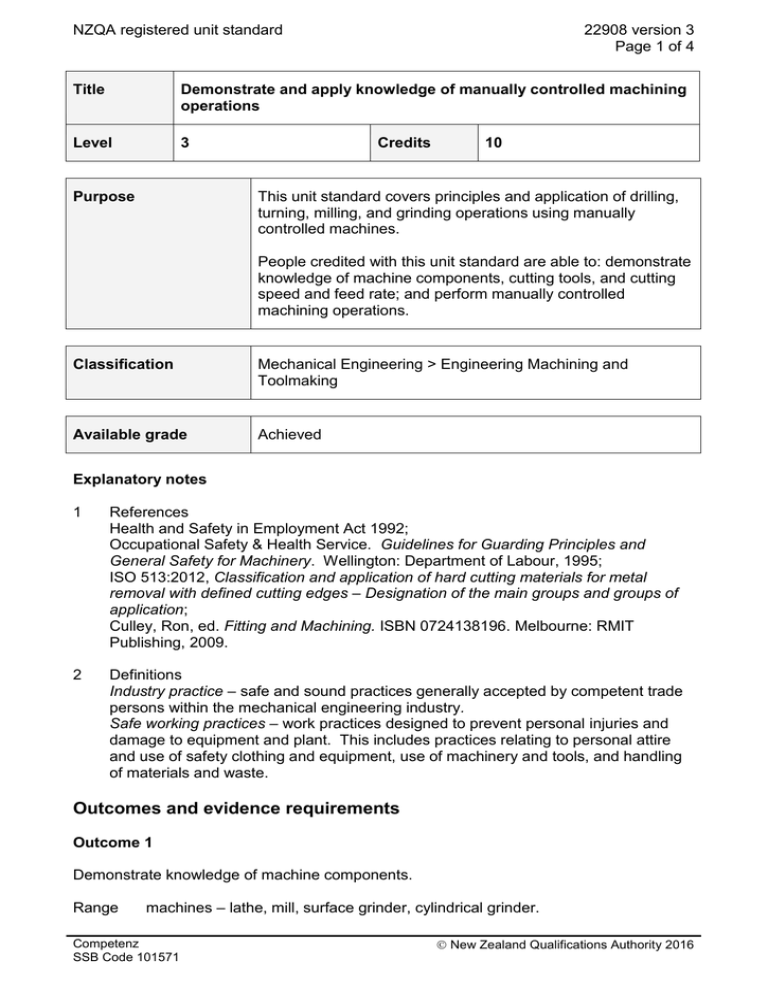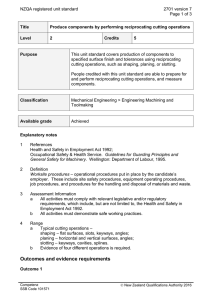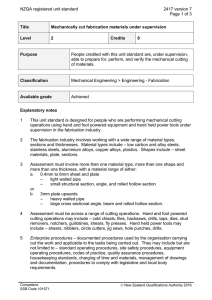NZQA registered unit standard 22908 version 3 Page 1 of 4
advertisement

NZQA registered unit standard 22908 version 3 Page 1 of 4 Title Demonstrate and apply knowledge of manually controlled machining operations Level 3 Purpose Credits 10 This unit standard covers principles and application of drilling, turning, milling, and grinding operations using manually controlled machines. People credited with this unit standard are able to: demonstrate knowledge of machine components, cutting tools, and cutting speed and feed rate; and perform manually controlled machining operations. Classification Mechanical Engineering > Engineering Machining and Toolmaking Available grade Achieved Explanatory notes 1 References Health and Safety in Employment Act 1992; Occupational Safety & Health Service. Guidelines for Guarding Principles and General Safety for Machinery. Wellington: Department of Labour, 1995; ISO 513:2012, Classification and application of hard cutting materials for metal removal with defined cutting edges – Designation of the main groups and groups of application; Culley, Ron, ed. Fitting and Machining. ISBN 0724138196. Melbourne: RMIT Publishing, 2009. 2 Definitions Industry practice – safe and sound practices generally accepted by competent trade persons within the mechanical engineering industry. Safe working practices – work practices designed to prevent personal injuries and damage to equipment and plant. This includes practices relating to personal attire and use of safety clothing and equipment, use of machinery and tools, and handling of materials and waste. Outcomes and evidence requirements Outcome 1 Demonstrate knowledge of machine components. Range machines – lathe, mill, surface grinder, cylindrical grinder. Competenz SSB Code 101571 New Zealand Qualifications Authority 2016 NZQA registered unit standard 22908 version 3 Page 2 of 4 Evidence requirements 1.1 The major components of machines are identified and their functions outlined. 1.2 Workpiece holding devices and accessories for machines are identified and their functions outlined with reference to application and safety. 1.3 The functions of coolant in machining operations are outlined. Range cooling, lubricating, chip removing, preventing corrosion. Outcome 2 Demonstrate knowledge of cutting tools. Evidence requirements 2.1 Terminology relating to cutting tool geometry is explained. Range wedge angle, orthogonal cutting, inclined cutting, normal rake, right and left hand cutting, plunge cutting, nose radius, clearance angle. Evidence of four terms is required. 2.2 The meanings of positive rake and negative rake are explained in terms of tool geometry. 2.3 The purpose of chip breakers is explained in terms of cutting tool operation. 2.4 The difference between solid tools and tool bits (inserts) is explained in terms of cutting tool operation. 2.5 ISO classifications of hard metals (carbides) are interpreted with the use of tables. 2.6 The important parameters of a twist drill are identified on a real, or representation of a, drill. Range 2.7 rake, lip clearance, point angle. ISO abrasive product markings are interpreted with the use of tables. Outcome 3 Demonstrate knowledge of cutting speed and feed rate. Evidence requirements 3.1 The terms cutting speed and feed rate as used in machining are defined. 3.2 The factors affecting tool life are identified. Competenz SSB Code 101571 New Zealand Qualifications Authority 2016 NZQA registered unit standard 22908 version 3 Page 3 of 4 3.3 The factors affecting cutting speed are identified. 3.4 Rotational speed in revolutions per minute is determined from a given cutting speed and diameter. 3.5 Optimum cutting speeds and revolutions per minute are determined for given materials, machining operations, and diameters using nomograms or tables. 3.6 Optimum feed rates are determined for given machining operations and materials. Outcome 4 Perform manually controlled machining operations. Range turning operations – turning stepped spindle, taper turning, form turning, drilling, reaming, boring, cutting threads, parting off, knurling. Evidence of five operations is required. milling operations – cutting flats, keyway, and T-slot; pitch circle drilling. Use of indexing head and rotary table must be demonstrated. surface grinding operations – truing and dressing a grinding wheel, grinding a flat face, square shoulder, internal and external diameters and shoulders. Evidence of three operations is required. drill sharpening – evidence of three drills of different sizes is required. Evidence requirements 4.1 Machining operations are performed on given machines in accordance with machine operating instructions, and using techniques in accordance with industry practice. 4.2 Machining is performed in accordance with safe working practices. 4.3 Optimum cutting speeds and feed rates are determined, and gears and other machine parameters set accordingly. 4.4 Machined workpieces are within specified tolerances. Planned review date 31 December 2017 Status information and last date for assessment for superseded versions Process Version Date Last Date for Assessment Registration 1 20 June 2006 13 December 2014 Rollover and Revision 2 17 November 2011 13 December 2014 Rollover and Revision 3 22 May 2014 N/A Competenz SSB Code 101571 New Zealand Qualifications Authority 2016 NZQA registered unit standard 22908 version 3 Page 4 of 4 Consent and Moderation Requirements (CMR) reference 0013 This CMR can be accessed at http://www.nzqa.govt.nz/framework/search/index.do. Please note Providers must be granted consent to assess against standards (accredited) by NZQA, before they can report credits from assessment against unit standards or deliver courses of study leading to that assessment. Industry Training Organisations must be granted consent to assess against standards by NZQA before they can register credits from assessment against unit standards. Providers and Industry Training Organisations, which have been granted consent and which are assessing against unit standards must engage with the moderation system that applies to those standards. Requirements for consent to assess and an outline of the moderation system that applies to this standard are outlined in the Consent and Moderation Requirements (CMR). The CMR also includes useful information about special requirements for organisations wishing to develop education and training programmes, such as minimum qualifications for tutors and assessors, and special resource requirements. Comments on this unit standard Please contact Competenz qualifications@competenz.org.nz if you wish to suggest changes to the content of this unit standard. Competenz SSB Code 101571 New Zealand Qualifications Authority 2016





